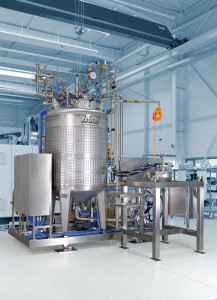The rules of hygienic design are aimed at completely cleaning and emptying a machine or system with the least possible use of cleaning agents. The mixing and dispersion technology specialist ystral has developed various technical solutions for effective cleaning. More and more ystral machines and systems are being constructed according to the rules of hygienic design: Every flange, every seal of a mixer or disperser is designed in a way that ensures easy and complete cleanability - without gaps, without threads, without hard-to-reach zones. Even critical areas, such as the underside of a mixer flange, can be cleaned shadow-free using special cleaning heads.
Disperser used as a CIP pump
CIP technology (CIP stands for Cleaning in Place) is integrated directly into the system to make cleaning processes as simple as possible and to keep the time required for cleaning to a minimum. Wherever possible, the conveying effect of the existing machines is also used for cleaning - a separate pump is therefore no longer required. This means that a ystral Conti-TDS dispersing machine operated in a circuit on a process tank can be used not only for processes such as aspiration, wetting and dispersing of powder materials and for pumping out the finished product, but also for circulating the cleaning medium. For GMP-compliant (Good Manufacturing Practice) cleaning, the flow velocity of the cleaning medium must be at least 1.5 m/s to prevent the formation of sediment and generate sufficient turbulence.  A process system specially designed to meet the requirements of a printing ink manufacturer, on which colour changes from black to yellow can be achieved within measurable contamination limits of 100 ppm . ystral machines are designed in such a way that, regardless of the size of the system, the flow velocity is usually as low as 2 m/s.
A process system specially designed to meet the requirements of a printing ink manufacturer, on which colour changes from black to yellow can be achieved within measurable contamination limits of 100 ppm . ystral machines are designed in such a way that, regardless of the size of the system, the flow velocity is usually as low as 2 m/s.
Cleaning with recipe ingredients
In previous practice in process engineering, containers are often cleaned with cleaning agents at the end of a process. This takes time and the resulting cleaning waste has to be treated or disposed of. An efficient alternative is cleaning with formulation components, which saves on liquid raw materials in the production of the batch, with which the system is rinsed out after pumping into a drain tank. For example, pigments are left directly in the process and do not have to be separated from the cleaning agent.
For successive batches with similar raw materials, cleaning is integrated into the process and takes place at the start of the following process. Residues of the previously manufactured product are recycled in the following batch. During filling, they are washed out under high pressure with recipe components from the subsequent batch instead of cleaning agents. Cleaning waste, which has to be laboriously removed and treated, is not produced.
The use of mist nozzles, for example, can prevent water-based inks from drying when the product is pumped out. Using such nozzles, the main liquid component is finely atomized in the container, creating a humid climate above the product that reliably prevents drying. This would not be possible with an open process. ystral has also developed cleaning concepts for the system periphery with powder and liquid handling and the cleaning of pump-out lines. For example, a specially designed rinsing quiver is used to clean suction lances. This quiver makes it possible to integrate the suction lance contaminated inside and out with the raw material into the CIP cleaning of the system when connected and thus - secured by a clamp - to clean it quickly and easily.
Development of individual cleaning concepts
ystral uses its experience in cleaning processes from sectors with very high hygiene requirements, such as the pharmaceutical or food industry, for applications in completely different sectors. In surface technology in particular, ystral solutions for the implementation of cleaning processes are always tailored to the specific system design and the respective application. For example, a process system specially designed for colour changes was developed for a printing ink manufacturer, on which colour changes from black to yellow can be implemented within measurable contamination limits of 100 ppm. In general, hygienic design systems in paint and ink production enable water-based products to be manufactured with a significantly lower use of biocides. The consistent avoidance of zones with little or no flow ensures that no germ nests can form.
Hygienic design as a competitive advantage
In many areas of the process industry today, flexibility is essential for survival: manufacturers must be able to produce a large number of product variants and newly developed products in line with orders and users, i.e. to realize frequent product changes. Optimized system design and simple, fast and resource-saving cleaning can give users from sectors such as the paint, surface technology and chemical industries in particular, where systems are often not yet constructed according to the rules of hygienic design, a competitive edge.


